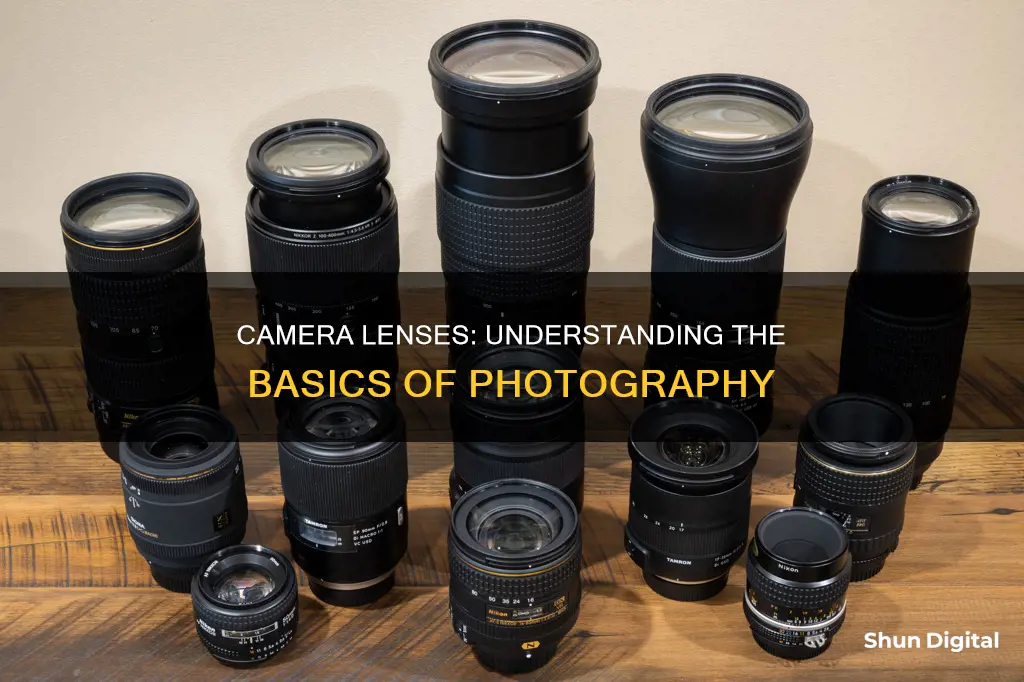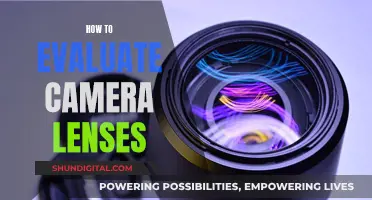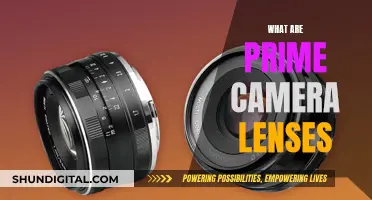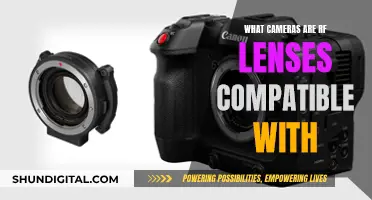
Camera lenses are an essential component of photography, shaping the way we see the world through the viewfinder. They are made up of a single or assembly of lenses that work in conjunction with a camera body to capture images. The creative use of lenses adds more control to digital photography, and choosing the right lens can be a complex trade-off between cost, size, weight, lens speed, and image quality.
The two primary types of lenses are prime and zoom. Prime lenses have a fixed focal length, while zoom lenses have variable focal lengths. Zoom lenses offer versatility and are ideal when photographing a variety of subjects, while prime lenses deliver higher-quality images for a specific type of photography.
Other types of lenses include telephoto, wide-angle, fisheye, macro, and tilt-shift. Lenses are also characterised by their focal length, aperture, and depth of field, which impact the field of view, light transmission, and how much of the image is in focus.
Understanding the various characteristics of camera lenses is key to capturing the desired image and developing one's photography skills.
| Characteristics | Values |
|---|---|
| Focal length | 50mm, 85mm, 100mm, 10-42mm, 70-200mm, 100-800mm, 7mm-16mm, 50-200mm, 35mm, 35-70mm, 70-200mm, 10-24mm, 50-60mm, 70-200mm, 300-600mm, 60mm, 105mm, 200mm, 85mm, 16mm-35mm, 18mm-270mm |
| Aperture | 1:2.8, 1:2.8-4, 1:3.5-5.6, f/2.8, f/3.5, f/5.6, f/2.8, f/2.0, f/1.4, f/4.0, f/3.0, f/1.4-2.8, f/1.8-f/1.4, f/3.0 |
| Focal ratio or f-number | f/0.7, f/2.8, f/2.0, f/3.0, f/1.4, f/4.0 |
| Angle of view | 50°, 60°, 180° |
| Magnification | 1:4, 1:1 |
| Field of view | Narrow, wide |
| Depth of field | Shallow, deep |
| Image quality | Aberrations, vignetting, distortion, blurring, reduced contrast, misalignment of colours, chromatic aberration |
| Lens type | Zoom, prime, telephoto, macro, tilt-shift, image-stabilization, fisheye, standard, normal, wide-angle, apochromat, process, enlarger, shift, stereoscopic, soft-focus, swivel, telecentric |
What You'll Learn

Focal length
The longer the focal length, the narrower the angle of view and the higher the magnification. Conversely, shorter focal lengths provide a wider field of view but lower magnification. For example, a lens with a short focal length will capture a much broader view than a telephoto lens.
Lenses can be divided into two types: prime and zoom. Prime lenses have a fixed focal length, while zoom lenses have variable focal lengths. The advantage of a zoom lens is its versatility. They are ideal when photographing a variety of subjects, such as landscapes and portraits, and you only want to use one lens. Zoom lenses are also convenient as they reduce the number of times you need to change the lens, saving time and limiting the possibility of dust entering the camera. Prime lenses, on the other hand, tend to be more compact and lightweight, and they usually have larger maximum apertures, making them ideal for shooting in low-light conditions.
Unveiling the Secret Behind Your Phone's Camera Lens
You may want to see also

Aperture
In addition to brightness and depth of field, aperture also affects the sharpness of an image. Using a very large aperture can result in a loss of sharpness, as the lens cannot physically produce the sharpest results when the diaphragm is fully open. Similarly, a very small aperture can cause an optical effect called diffraction, which results in a decrease in image quality. Therefore, it is recommended to use aperture settings between f/5.6 and f/11 to achieve optimal sharpness.
When choosing a lens, it is important to consider the maximum aperture, as this determines how much light the lens can gather. Lenses with larger maximum apertures, such as f/1.4 or f/1.8, are considered "fast" lenses and are typically more expensive.
In summary, aperture is a critical setting in photography that affects brightness, depth of field, sharpness, and shutter speed. By adjusting the aperture, photographers can control the amount of light reaching the sensor and create various visual effects to achieve their desired outcome.
Analog Camera Lenses: Interchangeable or Not?
You may want to see also

Prime vs. zoom lenses
A prime lens has a fixed focal length, meaning it has a set angle of view that cannot be changed. The only way to change the composition of a shot is by physically moving the camera. Prime lenses are often smaller, lighter, and cheaper than zoom lenses, and they also tend to have larger maximum apertures, which is useful for low-light photography and creating "bokeh" (a shallow depth of field). Prime lenses are also generally sharper than zoom lenses, as it is more difficult to create a zoom lens with consistently good optical quality throughout its focal range.
A zoom lens, on the other hand, has a variable focal length, allowing the photographer to change the angle of view by turning the zoom ring. This makes zoom lenses more versatile and convenient, especially in situations where the photographer is limited to a particular spot or cannot move around much. Zoom lenses are generally bulkier and heavier than prime lenses, and they tend to have smaller maximum apertures. They are also more expensive than prime lenses.
Both types of lenses have their advantages and disadvantages, and the choice between the two depends on the photographer's needs and preferences. Prime lenses are ideal for situations where a very shallow depth of field is desired, while zoom lenses are great for times when versatility and convenience are needed, such as when travelling or shooting a wedding.
Lenses for Full-Frame Cameras: What's the Difference?
You may want to see also

Lens speed
Fast lenses, with their wider apertures, are highly sought after as they allow photographers to use faster shutter speeds, making them ideal for capturing well-exposed photos in low-light conditions or when shooting handheld or moving subjects. The ability to use faster shutter speeds also helps to prevent noise in images by keeping the ISO down. Additionally, fast lenses provide greater control over depth of field and bokeh, making them popular for portrait photography, sports photography, and photojournalism. However, they come with a trade-off—they tend to be heavier and bulkier, and significantly more expensive than their slower counterparts.
On the other hand, slow lenses have smaller maximum apertures, resulting in reduced light intensity and the need for slower shutter speeds. While they may be adequate for certain types of photography, such as landscape or architectural photography, where a tripod is typically used and fast shutter speeds are not essential, they may struggle in low-light conditions.
It's worth noting that the classification of "fast" and "slow" lenses has evolved over time due to advancements in lens technology. Lenses with lower f-numbers are now considered faster, and modern lenses can achieve speeds that were previously unimaginable.
Ultimately, the choice between a fast or slow lens depends on the specific needs of the photographer. While fast lenses offer more flexibility and are ideal for certain genres, they may be unnecessary or burdensome in other situations due to their cost and weight.
Renting Camera Lenses: Best Places to Get Them
You may want to see also

Image quality
The lens is made up of several "lens elements", each of which directs the path of light rays to recreate the image on the digital sensor. The goal is to minimise aberrations while using the fewest and least expensive elements. Optical aberrations occur when points in the image do not translate back to single points after passing through the lens, causing image blurring, reduced contrast, or misalignment of colours (chromatic aberration). Lenses may also suffer from vignetting (uneven, radially decreasing image brightness) or distortion.
Other factors that influence image quality include:
- Sensor quality: Sensors with low noise, high dynamic range, and large size tend to produce better image quality.
- Lighting: The amount and quality of light available to the camera can greatly affect image quality.
- Focal length: The focal length of a lens determines its angle of view and how much the subject will be magnified. Wide-angle lenses have short focal lengths, while telephoto lenses have longer focal lengths.
- Aperture: The aperture of a lens refers to the amount the lens can open or close to let in light. Larger apertures (lower f-numbers) let in more light and are described as "faster". Smaller apertures provide a wider depth of field, with objects in focus over a wider range of distances.
- Lens coatings: High-quality lens coatings can minimise flare and improve image contrast.
- Perspective distortion: Using a wide-angle lens can introduce perspective distortion, where proportions in the subject appear stretched out.
- Chromatic aberration: This refers to colour artefacts introduced by the lens, such as red and blue fringes in the corners of the image.
- Bokeh: This refers to the quality of the photo's out-of-focus blur. Lenses with good bokeh have minimal texture and soft transitions.
While image quality is important, other factors such as size, weight, autofocus, durability, and price may also influence lens selection. Additionally, the technique of the photographer plays a significant role in the final image quality.
Cleaning Camera Lenses: A Step-by-Step Guide
You may want to see also
Frequently asked questions
A camera lens is an optical body that features a single lens or an assembly of lenses that mounts to a camera body. Some lenses are built into the construction of the camera itself, while others are interchangeable.
Focal length is the distance between the optical centre of the lens and the camera sensor or film plane when focused at infinity. The optical centre is where light rays converge inside the body of the lens. The focal length defines the magnification and field of view for a given lens. This value is most commonly measured in millimetres.
Zoom lenses have variable focal lengths, meaning the photographer can adjust the focal length within a pre-defined range. Prime lenses, on the other hand, have a fixed focal length. Zoom lenses are more versatile and allow for a variety of compositions or perspectives without needing to change lenses. Prime lenses produce higher-quality images and are more compact, lightweight, and affordable.







